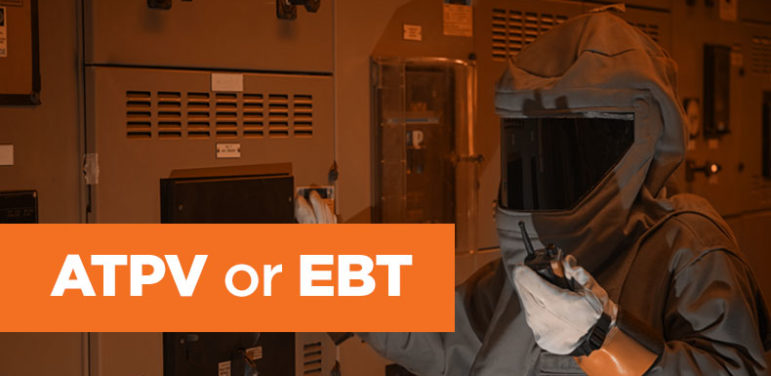A common question in arc flash clothing protection values is whether an ATPV or an EBT is better in protection in an Arc rated clothing system.
Under the ASTM F1959/F1959M (The Standard Test Method for Determining the Arc Rating of Materials for Clothing) it is observed that some materials allow body burn predictions to be reached before they “broke open” and others would be visa-versa. One situation is termed as ATPV – Arc Thermal Performance Value and the other is an EBT – Energy Breakopen Threshold.
There is possibly a misconception that ATPV is better than the EBT because the material tested did not exhibit the breakopen phenomena in case of the ATPV rating achieved. However, this is erroneous, and it has been determined that any fiber type or fabric construction can breakopen before its burn prediction level is reached.
Today everybody recognizes that knits usually breakopen before the burn point and woven cloth shows burns before the break open point.
Both these ratings thereby provide an arc rating to a textile material or the clothing system. One reason to call these ratings under one head – Arc rating, was to make the labeling less technical and easier for the end user to understand and the other reason was to take away a false stigma from EBT.
In the arc rated clothing labels the terms EBT and ATPV are used as a subscript or an addendum to the term Arc Rating for the safety professional to understand and define their requirements accordingly. So now we generally see an arc rated clothing carrying a label with Arc Rating (ATPV) = X cal/cm² or Arc Rating (EBT) = X cal/cm².
ATPV (Arc Thermal Performance Value)
ATPV (Arc Thermal Performance Value) is defined as the incident energy that results in a 50% probability that sufficient heat transfers through the specimen and causes the onset of second-degree burn injuries.
Energy Breakopen Threshold (EBT)
The incident energy on a material that results in a 50% probability of breakopen. Breakopen is defined as any open area of at least 1.6 cm² or 0.5 in.²
The EBT rated fabric does not exhibit a second degree burn on the calorimeter sensors in most cases because the material has a ½ square inch hole which is not directly over the sensor. Theoretically if this would have happened over the sensor there would have been a burn predicted under the crack or hole, so while testing the cut off rating is taken at this point.
Both these energy levels are expressed in cal/cm².
ATPV and EBT can both be evaluated in the same test under ASTM F1959. Both values can be reported, if needed, but only one which is the lowest of these two is the tested Arc Rating for the textile material and is mandatory to be labelled under the ASTM F1959 norm.
It is now easier to understand that EBT fabrics are typically more insulative than they are strong and ATPV materials are stronger than they are insulative. Generally, EBT is achieved more often in a knitted structure which is more comfortable and insulative but essentially no less protective to the user.
It is therefore suggested to never make a clothing protection decision based on the fact that the clothing received an ATPV or an EBT. Both these terms are functionally equivalent.



Leave a Reply